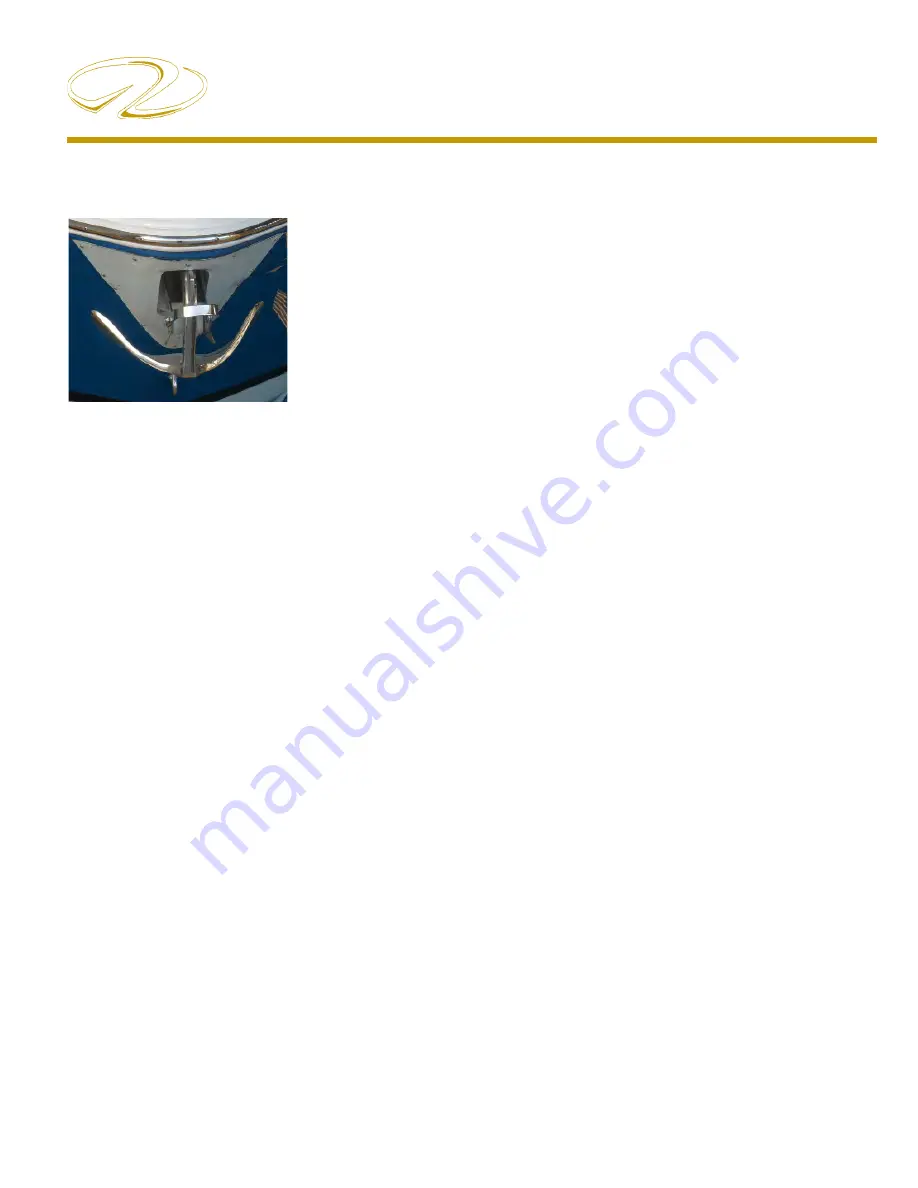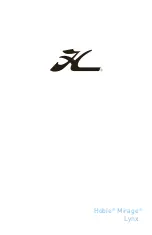
9
Vessel Operation
ANCHORING
Yo u r Re g a l y a c h t
features a stainless
steel plow type anchor.
The anchor will set
quickly in a variety of
bottoms because of its
unique shank profile
and ballasted tip. It is
a high holding type
anchor made from high
grade manganese steel and stainless steel for maximum
tensile strength. The anchor weight is 55 pound or (25) kg.
Anchoring is easier with another person on board. First be
certain that the line for the anchor is properly attached, to
avoid losing the anchor and anchor line overboard.
For more effi ciency, a 25’ length of galvanized chain has
been added to the rode length. The chain will stand up to
the abrasion of sand, rock, or mud on the bottom much
better than a nylon line. Being galvanized the chain will
resist corrosion. Approximately 175’ of 3 strand nylon
line has been added to ensure a adequate scope in different
depths and weather situations. The nylon will stretch under
a heavy strain cushioning the impact of waves or wind on
both the boat and the anchor.
To anchor, select an area preferably with a fl at bottom.
Mud, sandy clay and fi rm stand afford the best bottoms for
anchoring. Grassy bottoms often resist the anchor taking
hold and end up pulling out grass and roots. Contrary to
modern belief, you do not anchor while the boat is making
headway, or moving forward. In fact, the bow of the boat
should be brought slowly backward, while releasing the
anchor until it hits the bottom. To “snub the line” means
to stop its outward “pay” or movement.
Usually the length of anchor line used should be 5 to
10 times the depth of the water depending on weather
conditions. This ratio is called the “scope”; the minimum
scope under average conditions is 7 or 8:1. If the scope is
too short the anchor’s effi ciency is diminished. A longer
scope cushions the shock load on the entire system.
Once a scope is determined sometimes it is diffi cult to
know how much line to let out to reach the desired scope
especially at night. One way to mark an anchor line that
will identify the amount of line is to paint wide and narrow
bands from about 50’ to 150’ in 10’ intervals. The wide
bands equal 50’ and each narrow band would equal 10’.
Distinguish each 50’ band with a different color paint. This
can be done with “see in the dark” paint. Simply tape each
length for the appropriate band before painting it.
After you have anchored, check your position with
landmarks if possible. You need to continue to monitor
these landmarks to make sure you are not drifting. Since
anchoring can also be an emergency procedure, the anchor
and line should be readily accessible. Check anchor locker
to ensure an untangled anchor line.
Once anchored the anchor line must be secured to a strong
tie such as a cleat.
Do not rely on the windlass brake to carry the anchor rode load.
Use a series of full turns and half-hitches around the
cleat horn to prevent any line slippage or jamming. This
is important as the scope may need to be adjusted over a
period of time and you need swift access to the line.
For increased holding power in windy conditions, two
anchors are sometimes set. If your primary anchor drags,
you can run out your secondary anchor without picking
up the primary one. The important thing is to lay them
out at an angle. When setting two anchors, make sure they
are fastened to separate strong ties such as cleats. This is
done in case you need to adjust one later so the line must
be accessible.
Note: In times of high waves a buoy on the rode works as
a shock absorber and allows the vessel’s bow to ride the
wave crests without large strains being transmitted to the
set anchor. These plastic foam buoys can be purchased at
boating retail outlets.
Содержание 32 EXPRESS
Страница 1: ...2011 Sport Yacht Collection S Y h C ll 32 EXPRESS OWNER S MANUAL...
Страница 3: ...320102 12 6 2013 OWNER S MANUAL 32 EXPRESS...
Страница 32: ...11 Safety On Board NAVIGATION LIGHT RULES...
Страница 53: ...9 Rules Of The Road...
Страница 54: ...10 Chapter 3...
Страница 94: ...40 Chapter 4 TYPICAL 12 VOLT HELM SWITCH PANEL...
Страница 106: ...52 Chapter 4 TYPICAL ELCI AC CIRCUIT FLOW CHART VOLTS VOLTS VOLTS VOLTS LINE...
Страница 148: ...94 Chapter 4...
Страница 149: ...95 Systems...
Страница 150: ...96 Chapter 4...
Страница 151: ...97 Systems...
Страница 152: ...98 Chapter 4...
Страница 153: ...99 Systems...
Страница 154: ...100 Chapter 4...
Страница 155: ...101 Systems...
Страница 156: ...102 Chapter 4...
Страница 157: ...103 Systems...
Страница 158: ...104 Chapter 4...
Страница 159: ...105 Systems...
Страница 180: ...15 Engine Controls AFT FORWARD SIDEWAYS DIAGONALLY ROTATE JOYSTICK FUNCTIONS...
Страница 262: ...22 Chapter 8 OVERBOARD DISCHARGE PAN DRAIN TYPICAL VECTOR COMPACT AC SYSTEM AIR FILTER...
Страница 276: ...36 Chapter 8...
Страница 300: ...9 Troubleshooting STEREO DIAGNOSTIC CHART...
Страница 301: ...10 Chapter 9 STEREO DIAGNOSTIC CHART...
Страница 302: ...11 Troubleshooting STEREO DIAGNOSTIC CHART...
Страница 303: ...12 Chapter 9 TACHOMETER ELECTRONIC DIESEL...
Страница 304: ...13 Troubleshooting TACHOMETER ELECTRONIC DIESEL...
Страница 307: ...16 Chapter 9 THRUSTER BOW...
Страница 309: ...18 Chapter 9 TYPICAL WINDLASS...
Страница 329: ...6 Chapter 12 TECHNICAL DRAWINGS...
Страница 330: ...Technical Information 12 7 32 EXPRESS GALVANIC ISOLATOR WIRING...
Страница 331: ...Technical Information 12 8 TYPICAL NMEA 2000 NETWORK COMPONENTS...
Страница 332: ...Technical Information 12 9 32 EXPRESS ELCI AC CIRCUIT FLOW CHART TYPICAL...
Страница 333: ...Technical Information 12 10 32 EXPRESS MAIN AC SHIP S PANEL FRONT VIEW...
Страница 334: ...Technical Information 12 11 32 EXPRESS MAIN AC SHIP S PANEL REAR VIEW...
Страница 335: ...Technical Information 12 12 32 EXPRESS MAIN DC SHIP S PANEL FRONT VIEW...
Страница 336: ...Technical Information 12 13 32 EXPRESS MAIN 12 VOLT DC SHIP S PANEL WITH BREAKER SIZES REAR VIEW...
Страница 337: ...Technical Information 12 14 32 EXPRESS COCKPIT SWITCH PANEL...
Страница 338: ...Technical Information 12 15 32 EXPRESS BATTERY VSR CIRCUITRY...
Страница 339: ...Technical Information 12 16 32 EXPRESS BATTERY MANAGEMENT PANEL...
Страница 340: ...Technical Information 12 17 32 EXPRESS HELM SWITCH PANEL...
Страница 341: ...Technical Information 12 18 32 EXPRESS HELM BREAKER PANEL...
Страница 342: ...Technical Information 12 19 32 EXPRESS VOLVO IGN MERC ANALOG EVC...
Страница 343: ...Technical Information 12 20 32 EXPRESS FIREWALL TO MDP HARNESS ROUTING...
Страница 344: ...Technical Information 12 21 32 EXPRESS DECK HARNESS ROUTING FORWARD...
Страница 345: ...Technical Information 12 22 32 EXPRESS DECK HARNESS ROUTING AFT...
Страница 346: ...Technical Information 12 23 32 EXPRESS HULL HARNESS ROUTING...
Страница 347: ...Technical Information 12 24 32 EXPRESS GAUGE PANEL CONFIGURATIONS...
Страница 348: ...Technical Information 12 25 32 EXPRESS TYPICAL DC GROUND CIRCUITRY...
Страница 349: ...Technical Information 12 26 32 EXPRESS TYPICAL TRIM TAB SWITCH CIRCUITRY...
Страница 350: ...Technical Information 12 27 32 EXPRESS TYPICAL BATTERY MANAGEMENT PANEL CIRCUITRY...
Страница 351: ...Technical Information 12 28 32 EXPRESS TYPICAL GFCI CIRCUITRY...
Страница 352: ...Technical Information 12 29 32 EXPRESS TYPICAL FIRE EXTINGUISHER GROUND CIRCUITRY...
Страница 353: ...Technical Information 12 30 32 EXPRESS STEREO BLUETOOTH WIRING...
Страница 357: ...Technical Information 12 34 32 EXPRESS MACHINERY LAYOUT...
Страница 358: ...Technical Information 12 35 32 EXPRESS FUEL TANK EPA COMPLIANT...
Страница 361: ...Technical Information 12 38 32 EXPRESS COCKPIT SEATING POSITION PLAN...
Страница 362: ...Technical Information 12 39 32 EXPRESS RANGE OF VISIBILITY...
Страница 363: ...Technical Information 12 40 32 EXPRESS DIMENSIONS APPROXIMATE...
Страница 364: ...Technical Information 12 41 32 EXPRESS BOW PLAN WINDLASS...
















































